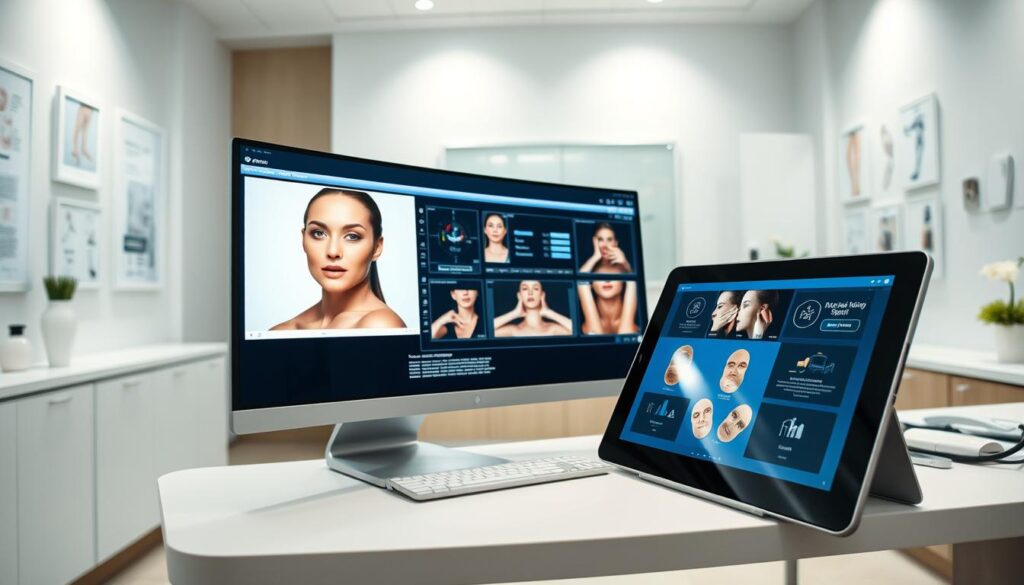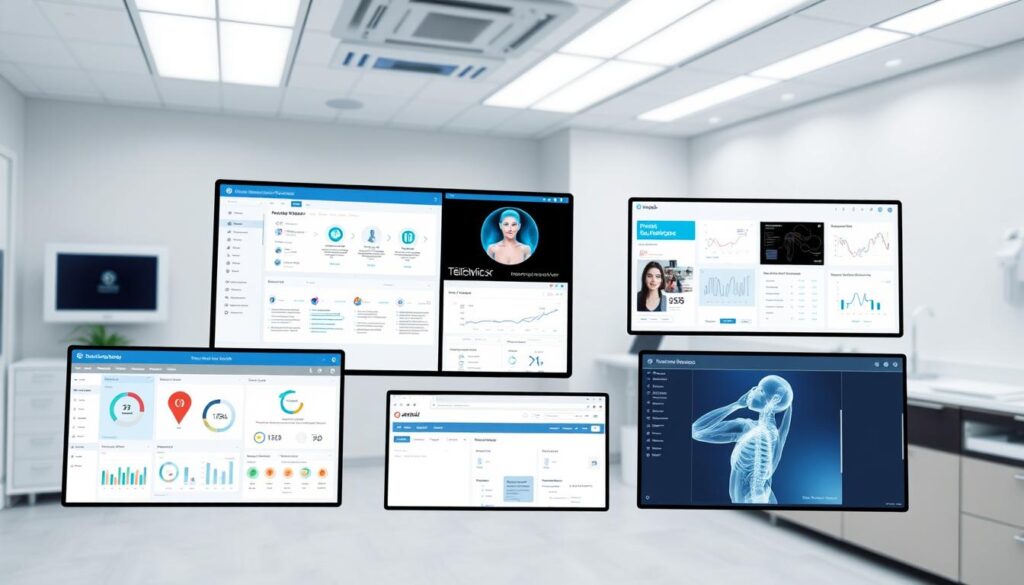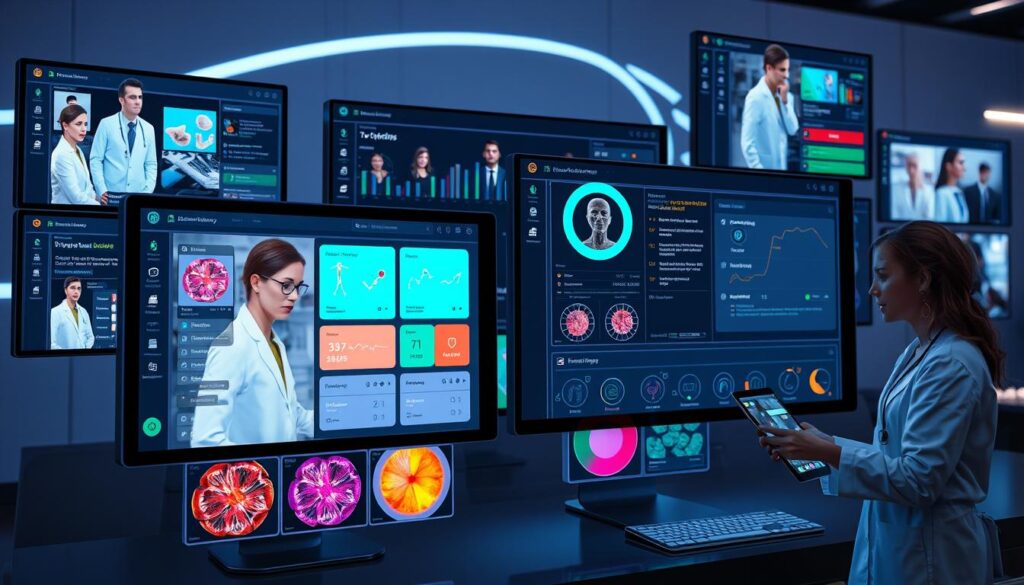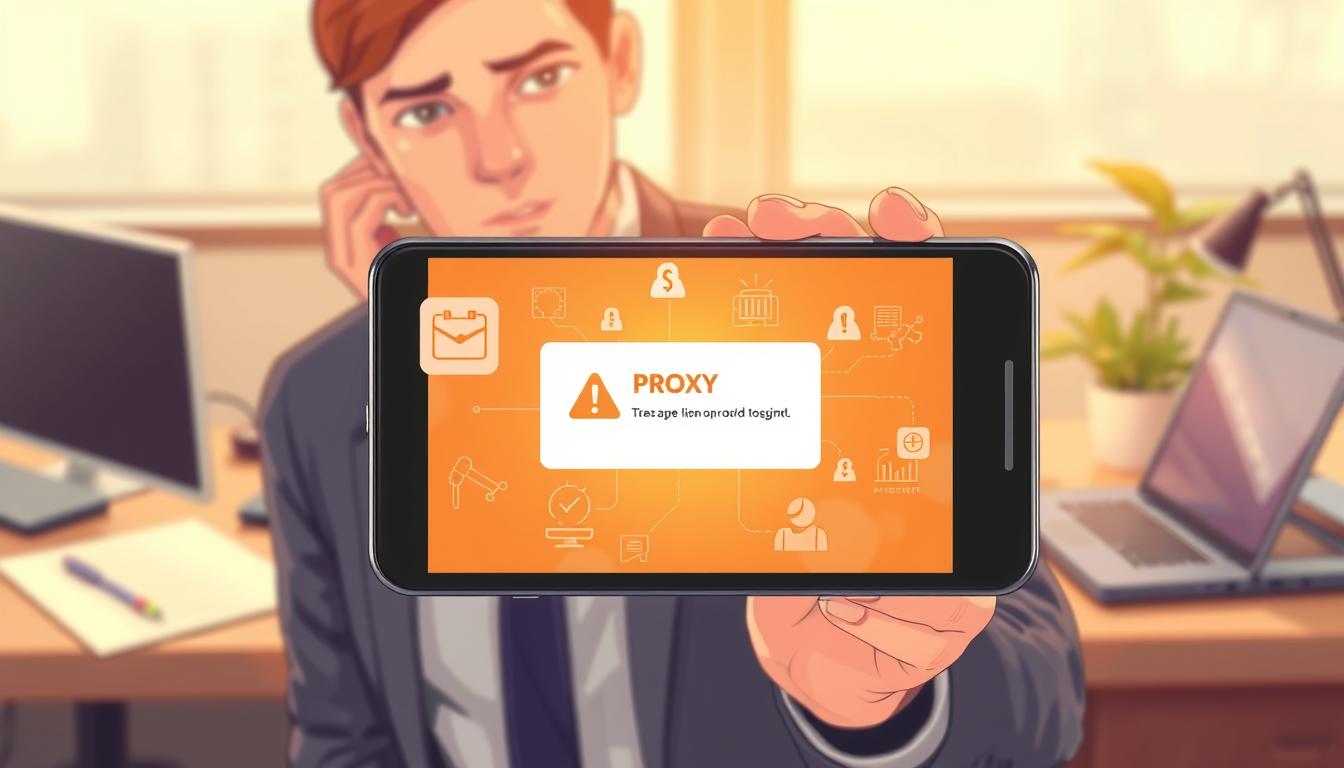FTC disclaimer: This post contains affiliate links and I will be compensated if you make a purchase after clicking on my link.
Finding the right dermatology software is crucial in today’s fast-changing healthcare tech world. With so many options, it’s hard to know which one fits your practice best. This guide will look at the top 10 dermatology software solutions. We’ll cover their main features, benefits, and things to consider to help you choose wisely.
Here’s a question to think about: Are you getting the most out of your dermatology practice? The right software can change everything. It can make your daily tasks easier, improve patient care, and boost your practice’s quality. Find out which dermatology software is at the top and can take your practice to the next level.
Key Takeaways
- Dermatology software has many features, like managing patients, scheduling appointments, and e-prescribing.
- It can automate tasks, saving money and reducing risks from manual work.
- It keeps patient data safe with digital storage, following HIPAA rules.
- It can make care better by improving communication and quick access to medical info.
- Important features include electronic medical records, diagnostic tools, reminders, and online booking.
Dermatology Software Overview
Dermatology software is a special medical software for skin care. It helps doctors and nurses manage skin conditions. It’s used in clinics, hospitals, and private practices.
What is Dermatology Software?
Dermatology software makes daily work easier for skin care professionals. It has features for managing patients and tracking treatments. This way, doctors can give better care to their patients.
Core Functionality of Dermatology Software
This software manages patients, schedules appointments, and keeps electronic medical records (EMR). It also handles e-prescribing, billing, and analytics. It has tools for labs and clinical notes. Some even have special modules for treatments like laser therapy.
“Dermatology software is a game-changer for our practice, allowing us to focus more on patient care and less on administrative tasks.”

- Efficient Patient Management: Dermatology software streamlines patient scheduling, medical history tracking, and communication, enhancing the overall patient experience.
- Customizable EMR and Documentation: Dermatology-specific templates and features simplify the documentation process, ensuring accurate and comprehensive patient records.
- Integrated Billing and Coding: Automated coding suggestions and seamless billing integration reduce administrative burdens and improve revenue cycle management.
- Specialty-Focused Analytics: Robust reporting and analytics tools provide valuable insights to drive informed decision-making and practice optimization.
Healthcare providers can work better with dermatology software. It makes their work more efficient and patient care better. It also helps them stay up-to-date in the fast-changing world of medical software.
Reasons to Use Dermatology Software
Dermatology practices can really benefit from using special software. These tools make many tasks easier, leading to big wins in Automation, Cost Savings, Quality of Care. They also boost Efficiency and Productivity.
Automation of Processes
Dermatology software makes many tasks automatic. It handles things like scheduling, patient records, billing, and prescriptions. This saves a lot of time and lets staff focus more on helping patients.
Cost Reduction
Using dermatology software can cut down on costs. It makes tasks less prone to errors and more efficient. This means less money spent on operations, helping the practice’s finances.
Improved Quality of Care
Dermatology software also makes patient care better. It keeps patient info accurate and helps staff talk better with patients. It also has features like digital images for better treatment plans. Plus, it keeps patient data safe, building trust.
In short, using dermatology software is a big win. It automates tasks, saves money, and improves patient care. This makes the practice more efficient and productive.
The Importance of Dermatology Software
Dermatology software is key for better care in skin health. It makes work easier and care better. It’s a must-have for today’s skin doctors.
It keeps patient records neat and easy to find. This helps doctors track and treat patients well. It’s very important for skin health, where looks matter a lot.
It also helps doctors make accurate diagnoses. With digital images, they can see skin problems clearly. This makes it easier to find and fix issues.
It makes billing easier too. This saves time and money. It also helps doctors follow rules for getting paid, which is good for everyone.
In short, dermatology software is very important. It helps manage records, improve diagnosis, and make work easier. This leads to better care for patients.

Features of Dermatology Software
Dermatology software has many features to make practice operations smoother and patient care better. It has strong electronic medical record (EMR) systems. These systems keep patient health histories, treatment details, and other important info safe and organized.
It also has advanced diagnostic tools like image annotation and condition-specific libraries. These tools help doctors make accurate diagnoses and track how treatments are going.
Reminder features in the software help everyone stay on the same page. Patients and staff get reminders for appointments, medication, and follow-ups. There’s also online booking for patients to schedule visits easily. This makes things more efficient for everyone.
Many platforms also offer telehealth for remote visits and tools for tracking skin conditions. They even have features for sending in medication refill requests. This makes workflows smoother.
Electronic Medical Records
EMR systems are key in dermatology software. They keep patient health records safe and easy to manage. Doctors can quickly access and update patient info. This ensures care is continuous and follows the rules.
Diagnostic Tools
Dermatology software comes with advanced diagnostic tools. These include image annotation and condition-specific libraries. They help doctors make accurate diagnoses and monitor skin conditions better. This leads to better patient outcomes.
Reminders
Reminder features in the software keep everyone informed. They remind patients and staff of upcoming appointments, medication, and follow-ups. This makes the practice run more smoothly and ensures patients get timely care.
Online Appointment Booking
The software lets patients book appointments online. This makes it easy for them to schedule visits. It also makes the practice more efficient and cuts down on paperwork.

Dermatology Software for Different Users
Dermatology software meets the needs of many in a healthcare practice. This includes patients, providers, and those who manage the practice.
Patients
Patients can book appointments and see their records online. They can also talk to their dermatologists. This makes healthcare better and more engaging for them.
Providers
Doctors, nurses, and assistants use the software to manage patient records. They can document visits, prescribe treatments, and track progress. This makes their work easier and care better.
Practice Management
Staff in practice management use the software for billing and reports. They can make decisions based on data. This makes the practice run smoother and patients get better care.
The best dermatology software meets the needs of all users. It makes operations smoother, patient care better, and healthcare outcomes higher.
| User Group | Key Features | Benefits |
|---|---|---|
| Patients |
|
|
| Providers |
|
|
| Practice Management |
|
|
The top dermatology software meets the needs of all users. It makes operations smoother, patient care better, and healthcare outcomes higher.

Best Dermatology Software
In the world of dermatology, top software helps manage practices better. EZDERM, Nextech, and EMA Dermatology stand out. They offer features that meet dermatology’s specific needs.
EZDERM
EZDERM is a top EHR with a user-friendly progress note feature. It has mobile support and a 3D Body Maps system. This makes data input easy and patient care better.
Nextech
Nextech is a full dermatology EHR and practice management system. It’s customizable for different workflows. It’s known for its patient and practice management tools.
EMA Dermatology
EMA Dermatology EHR has a Virtual Exam Room for quick data input. It also manages revenue and inventory well. This makes both clinical and admin tasks easier.
These dermatology software options meet the specialty’s needs. They help practices run better, care for patients more, and perform well. Using these platforms, dermatology practices can become more efficient and patient-friendly.
Choosing the Right Dermatology Software
When picking the best dermatology software, think about a few important things. The practice size matters a lot. Software is made for small, medium, or big practices. It has different features for each size.
Also, consider if the software is on-premise or cloud-based. This choice affects data safety, how easy it is to use, and how you can get to it. Make sure the software is ONC-ATCB certified. This means it meets important health rules.
Practice Size
Dermatology software is made for different practice sizes. Small practices might want something easy and cheap. But bigger practices need more features, like better reports and ways to connect with other systems.
Choosing software that fits your practice’s needs is key. It helps manage your practice well now and in the future.
System Design: On-Premise vs. Cloud
Choosing between on-premise and cloud-based software is big. On-premise gives you control but needs IT help. Cloud-based is easy to get to, grows with you, and saves on IT costs.
ONC-ATCB Certification
Make sure your software is ONC-ATCB certified. This shows it meets health rules. It keeps your patient data safe and secure.
Think about practice size, system design, and ONC-ATCB certification when picking software. This way, you find the best fit for your practice. It helps manage patient info and your practice smoothly.
EMR Software Overview
Electronic Medical Records (EMR) software is a digital system that changes how healthcare providers handle patient info. It lets you record, access, and update patient data. This includes medical history, diagnoses, treatments, and lab results. EMR software is key for modern healthcare, making workflows smoother, data more accurate, and patient care better.
EMR software helps meet rules while keeping patient records safe and efficient. It makes medical data digital and central, helping teams work better together. This leads to better patient care as healthcare keeps using new tech.
The Benefits of EMR Software
- Streamlined clinical workflows and increased productivity
- Improved data accuracy and reduced risk of errors
- Enhanced patient engagement and communication
- Compliance with industry standards and regulatory requirements
- Secure storage and easy access to patient records
- Improved collaboration and coordination among healthcare providers
- Better decision-making supported by comprehensive patient data
EMR software is now vital for top-notch, patient-focused care. It helps healthcare practices run smoother, manage data better, and improve patient and provider experiences.
| EMR Software | Key Features | Benefits |
|---|---|---|
| CureMD |
|
|
| EZDERM |
|
|
The healthcare world keeps changing, and EMR software is now key for top care, rules, and efficiency. By using these digital tools, healthcare providers can make a big difference in patient lives.
EMR Software by Specialty
Managing healthcare operations needs more than just one EMR software. Many practices choose EMR systems made for their specialty. For example, dermatology EMR software has tools for images and treatments. Pediatric EMR software has growth charts and immunization tracking.
Other EMR systems are for oncology, podiatry, and ophthalmology. They offer special features for each field. This helps doctors work better and care for patients more effectively.
Using EMR software made for your specialty has many benefits. It makes workflows smoother and helps with decisions. It also makes coding and billing easier and helps engage patients better.
- Streamlined workflows that align with your unique practice needs
- Enhanced clinical decision-making through specialty-specific tools and templates
- Improved coding and billing accuracy with built-in specialty coding and reimbursement support
- Better patient engagement through specialized patient education materials and communication features
When picking an EMR system, think about what your specialty needs. This ensures you get a system that fits your practice and patients well.
“The right EMR software can make a significant difference in the efficiency and quality of care we provide to our dermatology patients.”
Specialty-Focused EMR Solutions
General EMR software can be used for many specialties. But, specialty EMR solutions are more tailored. They meet the specific needs of fields like dermatology, pediatrics, oncology, podiatry, and ophthalmology.
- Dermatology EMR – Advanced image management, specialized diagnostic categories, treatment planning
- Pediatric EMR – Growth charts, immunization tracking, age-appropriate patient education
- Oncology EMR – Cancer-specific documentation, treatment protocols, population health management
- Podiatry EMR – Foot and ankle-focused assessments, orthotics management, wound care tracking
- Ophthalmology EMR – Visual field tests, optical coherence tomography (OCT) integration, vision screening
Choosing an EMR software made for your specialty can improve your practice. It makes workflows smoother, helps with decisions, and leads to better patient care.
Meaningful Use and MACRA
The healthcare world has changed a lot. This change came from the Meaningful Use program and the Medicare Access and CHIP Reauthorization Act (MACRA). The Meaningful Use program was part of the HITECH Act. It set rules for healthcare providers to use certified Electronic Health Records (EHR) software.
This program has grown into the Merit-Based Incentive Payment System (MIPS). MIPS is a key part of MACRA.
Now, healthcare practices are using EHR technology more. They see the benefits of better patient care, more efficiency, and money rewards. These rewards come from using certified EMR software well.
Doctors and other healthcare workers must join the Quality Payment Program (QPP) under MACRA. The QPP has two main parts: MIPS and Advanced Alternative Payment Models (APMs).
To meet MIPS Quality needs, most must report up to six quality measures. This includes an outcome measure for at least 90 days. There are 271 measures to pick from.
For MIPS Improvement Activities, most must attest to doing up to four activities. There are 93 activities to choose from.
The Advancing Care Information part of MIPS requires specific tasks. These include Security Risk Analysis and e-Prescribing. Providers must do these tasks for at least 90 days. They can also do more tasks to get extra credit.
MIPS data can be reported in several ways. This includes claims, registry, QRDC, web interface, and the CMS EHR Incentive Payment Attestation Site. In the first year, providers might need to use more than one method.
“Kareo Clinical is a 2015 Edition EHR that is compliant with the 2021 Cures Act updates and will continue to align with the Cures Act requirements through 2023.”
To join MACRA, clinicians need a certified EHR. Kareo Clinical has the right fields for MIPS data. Kareo also offers training to help with MACRA and using EHRs.
Benefits of EMR Software
Using EMR software has many benefits for healthcare. It makes patient care better by giving doctors quick access to patient records. This helps them make better decisions and coordinate care better.
It also makes practice efficiency and productivity better. This is because it automates tasks like scheduling, billing, and managing prescriptions. This saves a lot of time and effort.
Also, using certified EMR software can get you financial incentives. This is through programs like Meaningful Use and MACRA. It helps the healthcare industry move forward digitally.
Lastly, EMR software helps with compliance. It makes sure patient data is safe and follows rules like HIPAA. This is very important for keeping patient information secure.
| Benefit | Impact |
|---|---|
| Improved Patient Care | Immediate access to comprehensive patient records for informed decision-making and better care coordination |
| Increased Efficiency | Automation and streamlining of administrative tasks, leading to improved productivity |
| Financial Incentives | Qualifying for programs like Meaningful Use and MACRA through the use of certified EMR software |
| Compliance | Secure storage and management of sensitive patient data to meet regulatory requirements |
Overall, using EMR software is a smart choice for healthcare. It brings many benefits like better patient care, more efficiency, and following rules.
“Streamlining workflows through powerful capabilities in EMR Software enables dermatologists to focus on patient care, enhancing overall practice success.”
EMR Requirements by Practice Size
Electronic Medical Records (EMR) software needs vary by practice size. It’s key to know what your practice needs to pick the right EMR system.
Small or Solo Practices
Small or solo practices look for affordable, cloud-based EMR systems. They need something easy to use with little upkeep. Important features include simple data entry, secure online access, and easy admin tasks.
Medium-Sized Practices
Medium-sized practices, with 5 to 10 doctors, need more from their EMR. They want features for different specialties, easy sharing of data, support for many devices, and detailed reports. Customization to fit their needs is also important.
Large Practices
Large practices, with 15 or more doctors, need EMR systems that grow with them. They need to support many users, handle complex schedules, and work with various medical tools. They also need strong security and tools for managing patients.
Hospitals and Enterprise Organizations
Hospitals and big organizations have the most complex EMR needs. They need all the features of smaller practices plus more. This includes managing inventory, lab systems, pharmacies, and other software. They also need advanced analytics and reports.
Knowing what each practice size needs is key to choosing the right EMR. The right system can make your practice more efficient, improve patient care, and work well with your operations.
| Practice Size | Key EMR Requirements |
|---|---|
| Small or Solo Practices |
|
| Medium-Sized Practices |
|
| Large Practices |
|
| Hospitals and Enterprise Organizations |
|
Understanding EMR needs for different practice sizes helps healthcare groups choose the best EMR software. This ensures they meet their unique needs.
Why Your Practice Needs EMR Software
As a dermatology practice, using Electronic Medical Record (EMR) software is now a must. It’s not just for following rules like the Meaningful Use program and MACRA. EMR systems also bring many benefits that are key for today’s medical practices.
One big plus of EMR software is improved efficiency. It automates many tasks, making your practice run smoother. It also helps manage patient care better. This means you can give your patients the best care possible.
EMR software is also vital for regulatory compliance. It’s needed to avoid fines and get incentives. This keeps your practice in line with the latest rules and protects patient data.
Finally, EMR software helps you improve the quality of care. It uses data to help you treat patients better. This lets you focus on giving personalized care and making patients happy.
“The use of EMR software enables healthcare providers to deliver higher-quality, more personalized care to their patients, while also streamlining the overall management of the practice.”
Whether you’re small or big, getting EMR software is a smart move. It changes how you run your practice and care for patients. By using EMR, you open up new possibilities for your practice’s future.
What to Look for in EMR Software
Cloud-based EMR Software
When looking at EMR software, think about how it’s set up. Cloud-based EMR systems have big pluses over old-school on-premise ones. They let healthcare teams get to patient records and tools from anywhere with the internet.
This makes it easier for doctors to work well, whether they’re in the office or out. Cloud-based EMR also has top-notch security. It uses strong encryption and has good backup plans. This keeps patient data safe and follows important rules like HIPAA.
Cloud systems also grow or shrink as needed. This means you don’t have to spend a lot on new hardware like with on-premise EMR.
Other key things to look for are easy-to-use interfaces and tools made for specific needs. Also, how well it works with other health systems and its reporting tools. By checking these, you can find the right EMR for your practice. It should help you give better care and work more efficiently.
| EMR Software Features | Benefits |
|---|---|
| Cloud-based Deployment | Increased Accessibility, Enhanced Security, Scalability |
| Specialty-specific Functionality | Tailored Solutions for Dermatology Practices |
| Interoperability | Seamless Integration with Other Healthcare Systems |
| Reporting and Analytics | Improved Practice Efficiency and Decision-making |
Conclusion
In conclusion, dermatology software and EMR software are key for modern healthcare. They bring many benefits like better operations, care for patients, and follow rules. Dermatology software has special tools for skin care, like advanced tests and safe data storage.
EMR software changes how doctors handle patient info. It helps in making better decisions, coordinating care, and working more efficiently.
Healthcare places can pick the right software for their needs. This choice helps in giving great care, following rules, and growing the practice. As healthcare changes, using new software will be more important for quality care.
Cloud computing, artificial intelligence, and mobile tech are changing dermatology and EMR software. Practices using these tools will see big improvements. They will work better, make accurate diagnoses, and do well overall. This leads to happier patients and better health outcomes.








